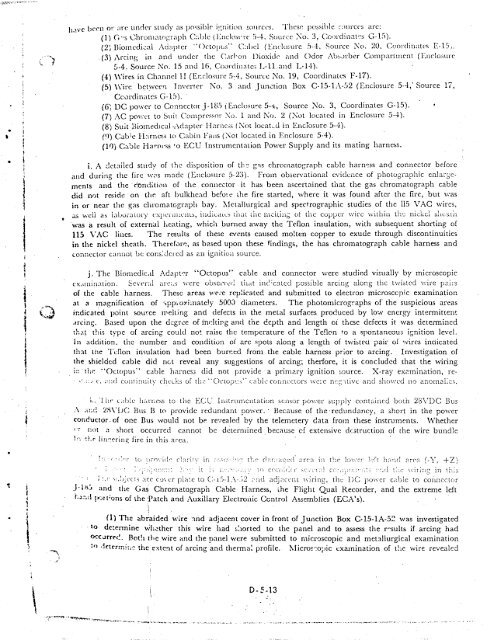Apollo 204 Review Board Appendix D - NASA's History Office
Apollo 204 Review Board Appendix D - NASA's History Office
Apollo 204 Review Board Appendix D - NASA's History Office
You also want an ePaper? Increase the reach of your titles
YUMPU automatically turns print PDFs into web optimized ePapers that Google loves.
¢<br />
i<br />
h:pec been or are under study as possible i!_-niiion sources. These possible c_mrces are:<br />
('1) G"s Chronmtograph CaMe (l'nclos_'rc 5-4, Sot'rce No. 3, Coordhmt"s G-15).<br />
(2_ Biomedical Adapter "'()ctotms" C:dml (EnCh_|||'e 5-4, Source No. 20, Coordinates E-I";_.<br />
(3) Arcing in and under tl_e Carl,on l)io×kie and Odor ,.\b_rber Compartme'_t (Ii:nclosure<br />
5-4.. Source No. 15 and 16, Coordinatc-_ L-11 and I.,-1.t).<br />
(4) Wires in Channel tI {Enclosure 5-,1, Source No. 19, Coordinatc_, F-17).<br />
(5) Wire bct_ween Inverter No. 3 and Junction Box C-15-1A-52 (Enclosure 5-4,' Source 17,<br />
CcoFdirh_ttCs G- l,b). "<br />
(6) DC power to Cnnnectorj-185 (Enclosure 5-,t-, Source No. 3, Coordinates G-15)•<br />
(7) AC t>ov.'et to Suit Comprcssc_r No. 1 and No. 2 (Not located in Enclosure 5-4).<br />
(8) Suit Biomedmal-Adapter I tarncss (Not located in Encrosure 54).<br />
(9) Cabie t larn_s to Cabin Fans (Not located in Enclosure 5-4).<br />
(1% Cable ttarncss 'o ECU Instz-amentation Power Supply and its mating harness.<br />
i. A detailed study of lhe disposition of tt',e gas chromatograph cable harness and connector before<br />
and during the fire was made (Enclosure 5-23). From observational evidence of photographic enlarge-<br />
ments and the c0nditiou of the connector it has been ascertained that the gas chromatograph cable<br />
did not reside on the aft bulkhead befo, e the fire started, where it was found after the fire, but was<br />
in or near the gas chromatograph bay. Metallurgical arid spectrographic studies of the 115 VAC wires,<br />
i<br />
nlCr_Cl<br />
as well as laboratory cxl)ciin:cnl-s, indicates tilac tlic ntcil, iltg of the copper wire within t}_.c '-: ' slitcatl).<br />
Was a result of external heating, which burneci away the Teflon insulation, with subsequent shorting of<br />
115 VAC lines. The resuhs of these events caused molten copper to exude through discontinuities<br />
in the nickel sheath• Therefore, as based upon these Findings, the has chromatograph cable harness and<br />
connector cg.lliltOt be coP, s[clclcd as &II ignitioa source.<br />
j. The Biomedical Adapter "Octopus" cable and connector were studied visually by microscopic<br />
c×amination. Several are:,s were obsctxcd ti_.,tt ind!catcd possible arcing along tile twisted ,,,'ire pahs<br />
of the cable harness. These areas we..'e replicated and submitted to electron microsccpic examination<br />
at a magnification of "_ppioxhnate!y 5000 diameters. The photomicrog-raphs of the suspicious areas<br />
indicated point source melting and defects in the metal surfaces produced by low cner_.%, intermittent<br />
arcing. Based upon the degree of inching and the depth and length oi these defects it was determined<br />
t}:a" ibis type of arcing could not raise the temperature of the Teflon to a spontaneous ignition level.<br />
In addition, ti:e number and condition of arc spots along a length of twistect pair of wires inciicated<br />
that the Tc.qon insulation had been burned from the cable harn_s prior to arcing. Investigation of<br />
the shielded cable did net reveal any suggestions of arcing; therfore, it is concluded that the wiring<br />
i:: *he "'Octopus" cable ha-'ness did not provide a primary ignition source. X-ray examination, re-<br />
, ,'.'.:_, c, ;_::¢! conli:'luity chccl-:s of the ;'Octopv's'" cable connectors we:e ncg-_tivc and showcd no anomalic;.<br />
k. "I hc cable harness to the ECU Instrumcl:tation sensor power supply contained botia 28VDC Bus<br />
A .m.'l 2RV!.)C Bus B to provide redundant power." Because of the.redundancy, a short in the power<br />
conductor.of one Bus would not be revealed by the telemetery data from these instruments. Whether<br />
,:r :mr a short occurred cannol be determined because cf extensive destruction of the wire bundle<br />
_,_'. .t?.e li:_erin_ fire in this area.<br />
!:: , :,'.,-r to ;,rc_,.id,_ cla:q_v in :,5_.' !,:'_ the d-'_r:_'gcd" ::r'.'a i:'a the lower },:ft ha_',d area (-Y, +Z)<br />
• ".:' v..l£cc:s a_Te co\or pla'e to C-iS-lY.-;2 :':id adjacent wiring, the 1)C; power cabin to connector<br />
.i'l_5 and tile Gas Chromatograph Cable Harness, the Flight Q.ual Recorder, and the extreme left<br />
La::d !,_tt;ons of the 'Patch and Auxiliary Electronic Ccntrol Assemblies (ECA's).<br />
i<br />
(I1 The abraided wire and adjacent cover in front of Junction Box C-15-1A-52 was investigated<br />
_o detennine _;hether this wire had shorted to the panel and to assess the results if arcing had<br />
occarred.. Both _he wire and the panel were submitted to microscopic and metallurgical examination<br />
:'_ determhae the extent of arcing and therma / profile. Microscopic cxmnination of the wire revealed<br />
!<br />
i D-5-13<br />
i .2.
















